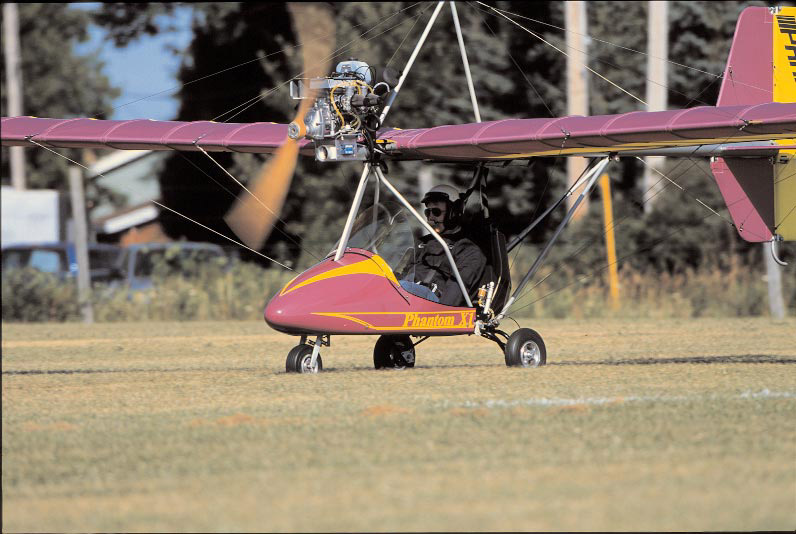
Phantom Aircraft Company President Pat Schultheis is ready for his takeoff roll in a Phantom X-1 at EAA AirVenture Oshkosh 2002.
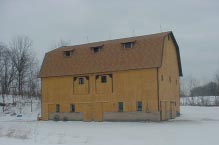
Pat’s complex on the “farm” includes this barn, known as the Hayloft Barn, along with an office, storage building, and assembly building and hangar. The Hayloft Barn is used for weddings, corporate parties, square dances, and a variety of other uses. Pat says, “I sometimes think of Homer Kolb using his farm to ‘grow’ his business. Although I don’t farm, I do grow ‘fun’ hobbies. I guess I’m in the business of manufacturing fun.”
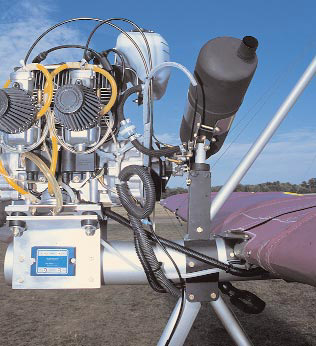
The Phantom X-1 that was flown at AirVenture 2002 was powered by a Rotax 503 engine with oil injection. Pat said many customers had doubts that oil injection would work well on the 503, so this installation was an attempt to quell those naysayers. Phantom’s installation of the 503 allows them to use free-air cooling instead of the usual fan-cooled setup, thereby saving some weight. Pat says cylinder head temperatures run about 50 degrees lower with this arrangement.
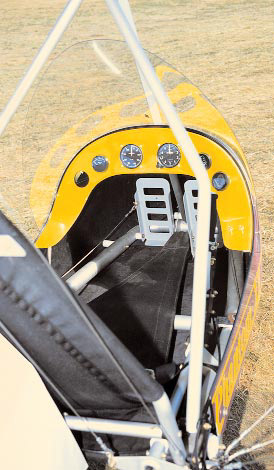
A slightly redesigned windscreen protects pilots from windblasts better than the original design did, and a new fairing design with a wraparound flange offers room for more instrumentation, without cramping leg movement. Instruments shown include airspeed indicator, tachometer and a combination EGT/CHT gauge.
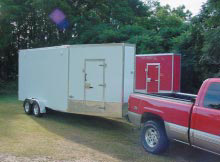
Phantom Aircraft added two different lines of trailers to their offerings. “We realized many ultralighters needed a way to store their plane or transport it to the airport or a fly-in,” Pat says. The all-aluminum trailers average about 1,270 pounds, and can be pulled with a minivan or sedan; a dual-wheeled vehicle isn’t necessary. Pat says they’ll custom build the trailer to meet the owners’ needs-currently they have 7 different floor plans.

A chromoly steel landing gear with welded braces has replaced the slab aluminum gear. Along with larger six-inch wheels, instead of the original four-inch size, the landing gear system provides more stable control.

Four-point shoulder harnesses are standard on both Phantom models. Connection points for the harnesses have been relocated so the belts will now put less pressure on an occupant’s shoulders in case of an impact.

Rotomolded polyvinyl fuel tanks are available as an option in 5- and 10-gallon sizes, in addition to the standard 5-gallon aluminum tanks. Pat says the tanks eliminated the problem of fiberglass breaking away and getting into fuel lines that was experienced with earlier tanks.
Phantom ultralights continue to charm many pilots
The proposed sport pilot and light-sport aircraft rule changes have been
the focus of much discussion and anticipation over the last several
months, and good reasons for such unbridled attention are plentiful.
Under the proposed rule, you can obtain
an FAA sport pilot certificate in as
little as 20 hours and then carry a passenger
without having to become a flight
instructor. Many interesting aircraft will
become available for purchase either as
kits or ready-to-fly light-sport aircraft
(LSA), and these machines will be more “capable” in that they will be faster, better
equipped, more comfortable, and
more closely resemble conventional aircraft.
In many ways, they will outperform
the general aviation aircraft they may
come to replace.
Experts expect financing and insurance
to become more readily available.
And access to America’s 12,000 airports
should follow. You’ll be able to buy fully
built LSA that will qualify for commercial
operations like flight training or rental.
And on top of everything else, a sport pilot
certificate requires either a valid U.S.
driver’s license OR a third-class medical,
making medical requirements less expensive
to meet.
Given all the strong arguments favoring
the new rule, why would anyone still
want to consider buying a single-place ultralight?
I have my answer to that
question—they’re simply fun to fly—but
many other excellent reasons exist.
Go Fly Alone!
Do you think you need two or four
seats in your aircraft for true aviation happiness?
I believe the answer is no. You
may need two or four or even six seats if
you want to transport people or to introduce
friends to light-airplane flying. Yet
for many pilots, the goal of happiness in
aviation is best achieved through solo
flight.
Look at sailplanes, aerobatic flying,
hang gliding, paragliding, or sky diving.
All these popular aviation sports are
largely done solo. When you fly alone
you have no one else to please or worry
about; you can make sure your flight experience
is exactly as you prefer it.
Single-place machines are less costly to
buy, build, fly, insure, and maintain.
Single-
place ultralights are more agile than
their heavier counterparts. Their lightness
allows them to operate from shorter strips
and suffice with smaller hangars; many
can fold up for trailer transport, which
saves hangar costs. And single-place ultralights
are easy to push around on the
ground.
In my view, few other air vehicles
deliver the fun of flight better than a
single-place ultralight. A single-seater
ultralight on floats is about as good
as flying gets, according to many enthusiasts.
Convinced Yet?
If you’re aware of or convinced by this
argument, then you need to think about
a flying machine like the Phantom X-1.
Several other Part-103-compliant ultralights
can be bought, but the Phantom
has a long and strong reputation and
meets the performance needs of many
pilots.
Over the past few months, I’ve had
friendly but vigorous discussions with
other ultralight experts. People who
should know better continue to think
that Part-103 ultralights cannot be purchased
anymore. They say the only
possible way is with a spartan-equipped
ultralight that uses the 28-hp Rotax 277,
an engine Rotax has ceased building because
of low consumer interest.
Over the years I have written several
articles about legal Part-103 ultralights
that are fun to fly. Sure, some require the
277 engine to meet the 254-pound weight
limitation of Part 103, but others do not.
Don’t tell me you cannot buy a Part-103
ultralight because I can prove otherwise.
Be honest. You may want more aircraft—
and that’s where LSA will come in—but
don’t blind yourself to the easily seen fact
that a variety of Part-103-legal ultralights
are on the market. Case in point: the
Phantom.
Frankly, it drives me nuts to hear people
state with conviction that no legal
Part-103 ultralights are for sale. If that’s
how I feel, imagine how Phantom Aircraft
Company president Pat Schultheis
feels.
The Phantom X-1 can indeed be built
to stay within Part 103, and it will do so
with the 40-hp Rotax 447 engine that
provides plenty of power and twin-cylinder
smoothness. True, Phantom Aircraft
offers a more capable Phantom, the X-1E,
but that does not meet Part-103 weight.
Its full enclosure, larger engine, added
structure, and options push it over the
line (though only by about 35 pounds).
However, Pat swears that you can meet
the 20-year-old rule with that model, if
you build carefully.
Phantom Expatriated
When Phantom Aircraft came to life,
it was a Connecticut-based company.
John Dempsey was the designer of the
original machine introduced by his company,
Ultralight Flight, at the Sun ’n Fun
EAA Fly-In in March 1982. Several hundred
machines were sold in the heyday
of ultralight growth during the early
1980s. As the industry matured, the original
Phantom owners sold the design to
a southeastern company who resold it a
few years later to a man in the furniture
business. The business moved to California
at one point. It was a slow period for
the famous name. But despite some
management shenanigans along the
way, Phantom, the machine, survived
nicely.
Eventually, new folks in North Carolina
purchased the business, and Pat,
being a Phantom enthusiast, became involved
with the operation. But in time,
those owners decided they wanted out of
the business. Pat’s friends in Kalamazoo,
Michigan, told him he was the logical
guy to buy the business, but having spent
29 years as a schoolteacher in a Michigan
school system, that prospect wasn’t
within his financial reach.
Pat tells the story of what happened
next. “I told 35 of my friends, well, if you
really think I should buy the company,
put your money with mine, and I’ll do it.
I’ll guarantee a personal note to everyone
who lends money, and I’ll pledge to pay
everyone back in three years, plus I’ll pay
interest along the way. My lawyer told
me I was nuts, but that was my personal
conscience. Three years to the day, everybody
was paid back.” Pat adds, “I really
didn’t want 35 shareholders telling me
what to do. I have one good woman looking
over my shoulder and that’s all I
need.”
Pat says the first few years weren’t
easy, but adds, “There’s some 1,500 Phantoms
out there, and old Phantoms don’t
die, they just get recycled, so there’s lots
of folks who need parts.”
After Pat bought the company, he
made several changes that separate the
new Phantom from the old one. His Kalamazoo,
Michigan-based enterprise
replaced the slab aluminum gear with a
chromoly steel landing gear. Ironically,
Pat originally developed the slab gear; he
says the new construction is tougher and
offers better ground clearance. Phantom
Aircraft now also offers six-inch aluminum
wheels as standard.
A new fairing has a wraparound flange
(an extended side section outside of your
knees) that allows placement of more instruments
for those who want them. The
windscreen was subtly reshaped to bring
it a bit higher and wider to enclose the
side support tubes. When the screen was
routed inside these tubes, more wind got
to the pilot; now the cockpit is surprisingly
calm.
The seatbelts were reattached in a new
place that keeps pressure off the top of
your shoulders in case of impact. Connected
up higher, the belts now better
restrain your forward movement, which
is desirable in mishaps.
The motor mount was changed, shaving
an impressive 50 percent of its
weight, from 23 to 12 pounds. A simple
swap exchanged the round forward engine
support tube (running from
nosewheel to engine mount) for a
streamlined tube. The shaped tube cuts
drag somewhat and also provides a clean
and neat way to hide wires that route
from the engine to the instruments. It
looks trick, too.
The Phantom’s pre-sewn Dacron wing
now splits in the center (like several other
ultralight aircraft), so that takedown for
trailer shipment is less time consuming.
To make transport by trailer even easier
and setup quicker, Phantom Aircraft
started offering a folding wing option for
$800.
All these changes made the Phantom
more polished. But for my money, Pat
did something even more important
when he bought the company. He made
a promise to take care of all owners.
Many of the kits supplied by previous
owners were shorted parts, yet Pat made
good to everyone. I’ve long said that
when you buy an ultralight airplane,
you’re marrying the company and its
people as much as buying an airplane. If
you don’t feel good about the company,
don’t buy the airplane unless you believe
you can handle all the details on
your own. Given Pat’s long experience
with Phantoms and his sense of ethics,
you won’t go wrong with Phantom Aircraft
of Michigan.
Give a Yank
If you want to comply with FAR Part
103, you’ll have to stick with a pull-rope
starter for the Rotax 447. I found this
challenging, as the Phantom’s cockpit is
rather small for a long, hard pull. I wasn’t
beyond asking Pat to help. I’m not a
fan of starting from the outside when
you are positioned so close to the spinning
prop. Yet an electric starter and its attendant battery and heavy electrical
cables will push you over the weight
limit of Part 103.
The Phantom’s sling seat may not
look comfortable to pilots accustomed to
padded, upholstered, metal-framed seats,
but the sling is actually quite supportive,
and it’s terrific in hot weather because it
breathes readily. If you need generous
lumbar support, though, you’ll need to
add the optional Velcro® pads.
The Phantom’s rudder pedals are
aimed back at you at a rather sharp angle.
They have a small lip at the bottom to
support your heels. Flying with my legs
nearly straight felt more comfortable
than I expected, though it may not be
optimal for long flights. On the other
hand, a legal Phantom with a five-gallon
fuel tank can stay aloft about two hours,
so stretching your legs can come with
fuel stops.
The Phantom won’t taxi turn quite as
tightly as some other ultralights, and no
change was made to steering linkages.
Fortunately ultralights don’t stay on the
ground long and bungee-cord suspension
helps smooth landings. Most owners fly
from rural airparks where taxiing is minimal
and space is generous.
I’ve enjoyed consistently great landings
in the Phantom X-1. My experience
with the design helps, but the Phantom
X-1 seems capable of making lots of pilots
look talented, thanks to a
combination of good low-speed handling
and forgiving performance
characteristics.
Pat advises 50 mph or better on approach,
but this insures a wide safety
margin as 40 mph—still the recommended
30 percent above stall—worked
well for me after a little practice. When
you’re ready for the slower speeds, you’ll
eat up less runway.
The Phantom displays a wide flare
window, probably because pitch is very
authoritative—partly a function of the
ventral fin area below the tail boom and
partly due to good empennage placement
in the prop blast. And to some pilots, a
higher sink rate on landing approach is
merely a means to touch down in a more
precise location.
With its side stick, the Phantom does
not permit control as briskly to the right
as to the left. Your right hand must work
the stick asymmetrically as it is positioned
on the right side of the cockpit.
This assures great leverage moving your
hand/arm to the left but restricts your
movement to the right. The good news is
you don’t need to move much in the X-1.
The Phantom ailerons are more powerful
than the rudder, a fact to keep in
mind while trying to slip to a landing. Remember,
the Phantom has no flaps. In
most maneuvering, I noticed generally
good control harmony despite the more
potent ailerons.
Roll rate measures about 2.5 seconds
for 45-to-45 reversal, although it seemed
marginally quicker to the left, probably
because of the stick position. You push to
the left versus pulling to the right, and
pushing works better in the Phantom
cockpit.
Phantom Flying
The Phantom’s 40-hp Rotax 447 with
two-blade wood prop zoomed up powerfully.
It felt at least as strong as the
factory’s statement of 700 fpm. More
powerful 50- or 65-hp Rotax engines are
optional for heavier pilots flying in higher
elevations, but you truly don’t need more
power if you’re of average height/weight
flying nearer to sea level.
Some legal 103 ultralights must use
small engines that limit their performance
enough that some pilots aren’t
interested. However, the Phantom X-1
can make the legal weight with the twincylinder
Rotax 447. The engine’s 40
horsepower gives this single seater plenty
of power; it can zoom to a couple thousand
feet in barely over two minutes.
You can cruise very comfortably at
5,000 rpm and see about a 55-60 mph
cruise airspeed. At full power, a 447-
equipped Phantom stays within the
55-knot/63-mph speed limit of Part 103.
Seeking a comfort zone, I experimented
with 4800-4900 rpm. At this
power I found that Phantom X-1 could
hold altitude well, and it will definitely
make you a quieter neighbor as you
cruise overhead. With such a reduction
comes less vibration, noise, and fuel
consumption.
Cable bracing to inboard and outboard
locations on both leading edge and
trailing edge—and a similar bracing
scheme for the tail—yields a very solid
feel in flight. You tend to notice bumps
more than some designs because of the
rigidly supported airframe. Some folks
think cable bracing brings more drag
than streamlined struts, but this is incorrect,
at least when cables are compared to
front and rear tubing sections with jury
struts.
I found I was unable to stall in fullpower
mode with the 447 engine; the
Phantom just kept climbing albeit in a
rather mushing flight. I backed off the
throttle and recorded power-off stalls
barely above 30 mph.
Power-on stalls showed less than 30
mph indicated at break. The Phantom X-
1 dropped its nose slightly though the
wing never really stopped flying. ASI error
below 30 mph with the nose held very
high is surely significant, so the number
can be considered little more than a reference.
But it was obvious to me the
Phantom has a genuinely slow stall.
Power-off stalls also broke at 30 mph;
they did drop the nose more convincingly
yet remained modest. A couple of
ultralight designs will stall slower and respond
gentler, but the Phantom’s stall is
recognizable for alert students and anyone
with a few hours in ultralight aircraft.
In all stalls the Phantom wallowed around
at the top of the stall to give you plenty of
warning that you must lower the nose.
As with earlier Phantom flights, I
found only a modest amount of adverse
yaw despite the presence of full-span
ailerons. (The Phantom design was one of
the first to popularize this configuration
among ultralights.) Part of the reason for
low adverse yaw qualities comes from the
tail’s generous vertical area. Of course, coordinated
use of the rudder cured the
problem.
Bargain-Priced
With a price tag of only $10,888 (with
a Rotax 447, or $8,888 less engine and
prop), you won’t spend a lot of cash, but
you’ll get everything you need. At a time
when the average new car costs twice as
much, the Phantom X-1 represents an excellent
value in my opinion. If you start
in Part 103 and eventually want to become
a sport pilot and fly your machine
as an experimental LSA, you’ll be pleased
to know that options like the enclosure
are retrofitable. You can start with the X-
1 and add goodies as soon as you have
your new sport pilot certificate. If you
make the switch during the sport
pilot/light-sport aircraft transition period
(currently defined as two years after the
effective date of the proposed rule), you
can register your aircraft as an experimental
LSA and continue to do your
own maintenance.
Whether Phantom Aircraft will build a
ready-to-fly LSA model Phantom in accordance
with the yet-to-be-finalized
consensus standards for LSA remains to
be seen. However, with rumors of a twoplace
model on the horizon and Phantom
Aircraft’s ability to supply highly finished
kits, it might be an easy step for the small
company.
In the last analysis, the Phantom is a
design with a long and successful history
now owned by an affable, knowledgeable
Phantom enthusiast. With manufacturing
done by people who have worked
with ultralights for a long, long time and
given its superb flying qualities, no wonder
the single place Phantom X-1 remains
famous as one of ultralight aviation’s
most enduring models. If you want a little
more power, an enclosure, and more
speed, a 503-powered Phantom X-1E
might just be your dream machine.
Most of the Phantom owners I’ve spoken
to over the years have said they love
their Phantom and they’re sticking with
it proudly. With a fan club that strong, I
imagine Phantom Aircraft will continue
its selling ways. Plus, if you stay with Part-
103 aircraft like the X-1, you could make
a purchase today, fly legally forever, and
have less regulation to boot.
Sounds like a winning combination
to me.
| Seating | Single-seater |
| Empty weight | 250 pounds |
| Gross weight | 510 pounds |
| Wingspan | 28 feet 5 inches |
| Wing area | 142 square feet |
| Wing loading | 3.6 pounds per sq ft |
| Length | 16 feet 6 inches |
| Height | 8 feet 2 inches |
| Fuel Capacity | 5 gallons |
| Kit type | Assembly |
| Build time | 125-150 hours |
| Standard engine | Rotax 447 |
| Power | 40 hp at 6,500 rpm |
| Power loading | 12.8 pounds per hp |
| Cruise speed | 55 mph |
| Economy Cruise | 2.5 gph |
| Stall Speed | (power off) 30 mph |
| Never exceed speed | 100 mph |
| Rate of climb at gross | 700 fpm |
| Takeoff distance at gross | 300 feet |
| Landing distance at gross | 450 feet |
| Range (powered) | 110 miles |
| Standard Features | Removable wings (kingpost and cable-braced), side-mounted joystick, full-span ailerons, instruments (ASI, tach, EGT/CHT), sling seat, 4-point shoulder harness pilot restraint, 6-inch aluminum wheels, pilot fairing, windshield, dash panel, 2-blade wood prop, dynafocal engine mount. |
| Options | Rotax 503 or 582 engine, electric start, high-lift wings, drum brakes, manual trim tab, full enclosure with doors, rear enclosure, 3-blade composite prop, prop spinner, snow skis, floats, 10-gallon fuel tank, padded seat, ballistic emergency parachute, chromoly landing gear. |
| Construction | Aluminum tubing, stainless steel cables, AN and MS hardware, Dacron® sailcloth covering. |
Design
Cosmetic appearance, structural integrity, achievement of design goals, effectiveness of aerodynamics, ergonomics.
Pros – The Phantom was a great design when it first appeared in the early ’80s, and it remains great today – that’s staying power! Current 2-year-old company introduced a fully enclosed model (the Phantom X-1e) and it looks good. Very strong design, thanks to cable-bracing and strong structural members. Company owned and backed by solid core of Phantom lovers.
Cons – Though some of us tire of hearing it, many pilots believe cable-bracing is old-fashioned or has more drag than struts (they don’t have more drag, say experts). No 2-seater offered as yet.
Systems
Subsystems available to pilot such as: Flaps; Fuel sources; Electric start; In-air restart; Brakes; Engine controls; Navigations; Radio; (items covered may be optional).
Pros – The Child’s Play Phantom featured electric starting. Panel room extended to allow more instrumentation. Primer is cockpit-accessible and was placed near the ballistic parachute deployment handle, a good location in my opinion. Fueling is done outside the pilot area, avoiding smelly spills in the cockpit. Optional brakes worked well in traffic situations.
Cons – Standard pull starting can prove challenging while belted in the seat (optional electric start alleviates the problem, but may push you over the Part 103 weight limitation). Like most aircraft brakes, they were a little weak at speed. No flaps available (though slipping helped).
Cockpit/Cabin
Instrumentation; Ergonomics of controls; Creature comforts; (items covered may be optional).
Pros – Secure feeling, large diameter tubing cockpit offers more crash protection than some ultralights. More panel space created with side sections. Less windy thanks to slightly larger windscreen; fully enclosed Phantom X1-e obviously provides complete protection. Sidestick makes for roomy cabin. Four-point shoulder harness pilot restraint is standard.
Cons – Entry remains challenging for less-flexible pilots; you must wiggle around the side cockpit tube member. Sling-style seat is comfortable for shorter flights but became less so for me after an hour. No baggage accommodations.
Ground Handling
Taxi visibility; Steering; Turn radius; Shock absorption; Stance/Stability; Braking.
Pros – Being tractor-configured, the Phantom sits stably on all three wheels, not tilting aft like many pusher ultralights. Newer tubular steel gear (formerly a slab gear-style) gave a very firm ride yet benefited from a small bungee suspension on one leg member. Strong gear and adequate clearance make emergency landings less uncertain.
Cons – Upward visibility is limited by high-wing design and close tractor-mounted engine. Turning radius is wider than some ultralights. Brakes are nondifferential so no assist in taxiing.
Takeoff/Landing
Qualities; Efficiency; Ease; Comparative values.
Pros – Very good takeoff and landing qualities; takeoff in particular is very simple, and I’ve never had a bad Phantom landing. Very good crosswind controls; here’s an ultralight to be flown in some wind. Authoritative pitch makes for landing flare that follows your demand. Rough fields are handled by robust gear and good clearance.
Cons – Sink rate was higher than average ultralight (though this can be put to good use in landings). No flaps, and slips are less effective in the nonenclosed Phantom. Braking power is limited on fast landings.
Control
Quality and quantity for: Coordination; Authority; Pressures; Response; and Coupling.
Pros – Strong control action in all axes. Particularly authoritative pitch. Harmony between the control surfaces was quite good even though ailerons appear to be more powerful than the rudder, perhaps a function of the direct rudder linkage. Newer “He-Man” bars allow better stick range for all pilots and especially for big guys.
Cons – tstar (a similar ultralight, but one which has discreet ailerons and flaps). Rudder pedals seemed to have an unusual angle at first (I came to like them later). It’s hard to fault Phantom handling – the design and its qualities remain a success even after pioneering ultralight aviation.
Performance
Climb; Glide; Sink; Cruise/stall/max speeds; Endurance; Range; Maneuverability.
Pros – High-lift wing with close rib spacing yields a potent climb with the 50-hp Rotax 503 dual carb (a Rotax 447 is required to meet Part 103). More power would be superfluous in my opinion; Child’s Play performed wonderfully with 50 horses. The Phantom also slows down well – maintaining its handling – for low-over-the-field flying that ultralighters love.
Cons – Sink rate is higher than average, probably a function of 142 square feet of wing area (though optional high-lift wing variation is better than some older models). In this category, as well, it’s hard to criticize Phantom performance.
Stability
Stall recovery and characteristics; Dampening; Spiral stability; Adverse yaw qualities.
Pros – Stalls are low at close to 30 mph power-off. Full-power stalls keep climbing. Longitudinal stability and response to power changes were both very positive. Child’s Play flew dead straight when hands off, an unusually good performance (I partly credit the solid cable-braced airframe).
Cons – Power-off stalls lose some altitude when they break. A lower dihedral allows some overbanking tendency in steeper turns (though aerobatic pilots probably prefer this quality).
Overall
Addresses the questions: “Will a buyer get what he/she expects to buy, and did the designer/builder achieve the chosen goal?”
Pros – Good solid company ownership has replaced short-lived previous ones; same personnel making parts for many years (and many owners). The Phantom ultralight is a long-time survivor improved by various refinements, notably by current ownership. Excellent value at $9,888 complete with “everything you need to fly,” says the factory. With the basic (and plenty powerful) Rotax 447, the Phantom can make Part 103 weight, according to the company.
Cons – Some pilots just don’t get it about cable-bracing, and because they don’t, your resale options become more limited. You don’t really want to break this ultralight down – it’s a long process (though better than older models!). Entry is tough enough that some won’t “qualify.”


Leave a Reply